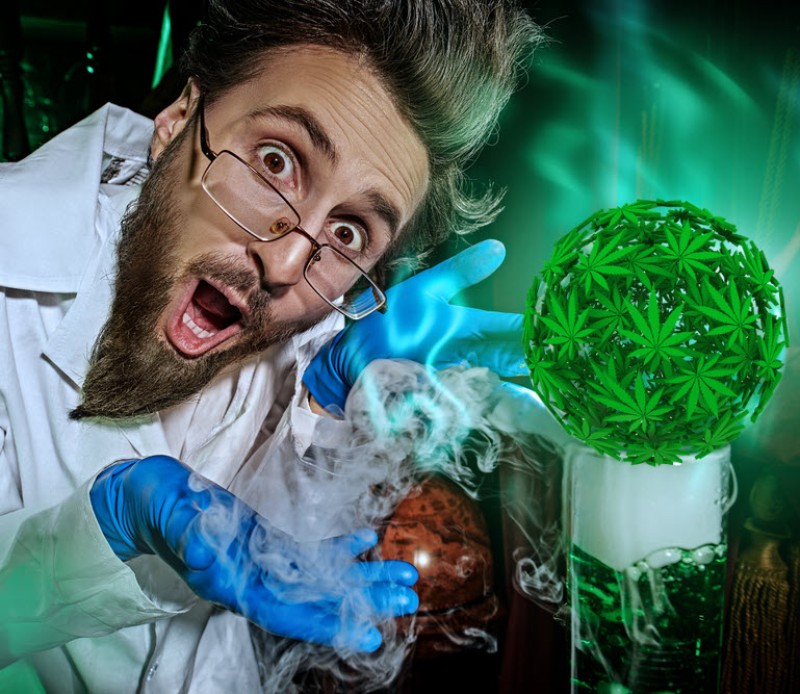
Science Based Weed Strains: GSD"
After decades of writing about cannabis, I've become increasingly convinced that we've only scratched the surface of what this miraculous plant can offer humanity. While most folks are familiar with THC and CBD, the cannabis plant contains hundreds of compounds that interact with our bodies in fascinating and complex ways. We're like children playing with blocks, just beginning to understand the intricate architecture possible when these compounds work in concert.
Think about it - there are over 100 known cannabinoids, more than 150 terpenes, and countless other bioactive compounds in cannabis. The potential combinations are staggering, and each could potentially produce unique effects. As our understanding of these mechanisms deepens, we're approaching an era where we can design cannabis strains for specific purposes, much like a master perfumer blending scents or a pharmaceutical researcher developing targeted medications.
This isn't just theoretical anymore. Earlier this year, I caught wind of something that perfectly illustrates this potential - a groundbreaking new strain called "Get Sh!t Done" (GSD). What caught my attention wasn't just its clever name, but its impressive THCV content - a lesser-known cannabinoid that's typically found in trace amounts. The developers claim they've created something remarkable: a strain that provides energy and focus without the traditional downsides of cannabis use like fatigue, mental fog, or the dreaded munchies.
As someone who's watched countless strains come and go, often accompanied by grandiose marketing claims, I'll admit I was skeptical at first. But this one's different - it's backed by actual clinical research and reproducible results. Let's take a deeper look at what makes this strain so special and what it might mean for the future of cannabis development.
A Deep Dive on the Strain and Science
When Natural Natural announced they'd developed a strain containing 15-20% THCV, it raised more than a few eyebrows in the cannabis community. For context, most strains contain only trace amounts of THCV, typically less than 1%. Creating a strain with these levels while maintaining an 8-week flowering time is nothing short of revolutionary.
But what exactly makes THCV special? While its molecular structure closely resembles THC, THCV interacts with our endocannabinoid system in profoundly different ways. Think of THC as a key that fully opens a lock - in this case, the CB1 receptor in our brain. THCV, on the other hand, acts more like a dimmer switch. At lower doses, it can actually block these receptors, while at higher doses it activates them differently than THC does. This unique interaction explains why THCV doesn't cause the typical "stoner" effects we associate with cannabis.
The real game-changer here is the clinical validation. Natural Natural didn't just breed a high-THCV strain and call it a day - they put it to the test. In their IRB-backed study, they found some fascinating results. Users of GSD reported 20% higher energy levels compared to control groups, and perhaps most interestingly, those who consumed traditional THC-only products reported feeling fatigued approximately three times more often than the GSD group. As someone who's written extensively about cannabis research, I can tell you that this kind of clinical validation is unfortunately rare in our industry.
Whitney Conroy from Natural Natural shared some insights with me that I found particularly intriguing. "THCV interacts with receptors in the brain differently. It is not impairing like THC. One study showed that THCV can improve response time in tests of impairment." This challenges the traditional narrative about cannabis use and cognitive function.
What excites me most about GSD isn't just what it does, but what it represents for the future of cannabis development. As Conroy explains, "We believe that the cannabis plant has endless opportunities... Breeding over the past 60 years has focused on THC potency. We believe it is time to move Beyond THC and bring back this diversity of chemistry to harness the power of cannabis truly."
I couldn't agree more. For too long, the cannabis industry has been fixated on THC percentages, treating them like the alcohol content of beer. But cannabis isn't alcohol - it's infinitely more complex and nuanced. GSD represents a shift toward purposeful breeding, where strains are developed not just to get users high, but to produce specific, beneficial effects.
The success of GSD suggests we're entering a new era of cannabis development, where science, not marketing, leads the way. And if this is just the beginning, I can't wait to see what comes next.
The Future of Cannabis
Having spent years observing and writing about the cannabis industry, I've developed some strong opinions about where we're headed. In my view, we're witnessing the early stages of a major transformation that will eventually split cannabis into three distinct categories: Recreational, Medical, and Industrial. While these categories technically exist today, the lines between them will become much sharper and more defined in the coming years.
The medical segment particularly fascinates me. I believe we'll see it evolve away from the familiar "smoke your medicine" approach that currently dominates the market. Let's be honest - while smoking flower might be enjoyable, it's not the most efficient or precise way to deliver medical benefits. The development of strains like GSD points toward a future where medicinal cannabis more closely resembles traditional pharmaceuticals or supplements, with precise dosing and specific, targeted effects.
Industrial hemp is already carving out its own niche in the American economy, and I expect this trend to accelerate. From sustainable building materials to biodegradable plastics, the applications seem endless. But it's the recreational market where I anticipate the most interesting developments.
The emergence of strains like GSD suggests we're moving beyond the simple paradigm of "getting high" toward something more nuanced and purposeful. I envision a future where recreational cannabis splits into two main branches: classic recreational experiences (what we typically think of as getting high) and what I call "functional enhancement" - strains specifically designed to complement different activities and states of mind.
Imagine walking into a dispensary and finding joints specifically designed for different experiences: one for creative work, another for social situations, maybe even one for physical exercise. It's not just about getting high anymore; it's about choosing the exact kind of experience you want. The success of GSD's THCV-dominant profile shows there's already a market for this kind of targeted effect.
However - and this is a big however - all of this potential remains somewhat constrained by federal prohibition. The current legal landscape is like trying to run a marathon with your shoelaces tied together. The inability to conduct unrestricted research, move products across state lines, or access traditional banking services continues to hold back innovation. Just imagine what companies like Natural Natural could achieve if they had the same freedom to research and develop as other industries.
Despite these challenges, I remain optimistic. The cannabis industry has shown remarkable resilience and creativity even under restrictive conditions. When - not if - federal legalization finally arrives, I believe we'll see an explosion of innovation that will transform cannabis in ways we can barely imagine today. The cannabis industry of 2030 might be as different from today as today's legal market is from the underground scene of the 1990s.
One thing's for certain - we're living through a fascinating period in cannabis history, and developments like GSD are just the beginning. The future of cannabis isn't just bright; it's technicolor.
The Sticky Bottom Line
After spending considerable time analyzing GSD and its implications for the cannabis industry, one thing has become crystal clear to me - we've entered a new era of cannabis development. The introduction of scientifically-backed, purpose-bred strains like GSD isn't just another product launch; it's a paradigm shift in how we approach cannabis cultivation and development.
When I think back to my early days writing about cannabis, most conversations centered around THC percentages and whether indicas or sativas produced better highs. Now, we're discussing clinical trials, specific cannabinoid ratios, and targeted effects. It's like watching a garage band evolve into a symphony orchestra - same basic elements, but infinitely more sophisticated.
As cannabis laws continue to relax (and trust me, they will), we'll see an influx of bright minds and serious innovation in this space. Combine this with the exponential learning capabilities of AI and advanced genetic research tools, and the potential becomes staggering. We're talking about new medicines that could revolutionize mental health treatment, recreational products that enhance rather than impair, and industrial applications we haven't even dreamed of yet.
It's wild to think that less than a century ago, "Reefer Madness" propaganda was convincing people that cannabis would turn them into murderous fiends. Now, we're developing strains that help people focus and get work done. The irony isn't lost on me.
We're living through what future historians will likely consider the renaissance of cannabis. The development of strains like GSD is just the beginning. As someone who's dedicated their career to understanding and writing about this remarkable plant, I can tell you - the best is yet to come. Stay tuned, fellow enthusiasts. The cannabis story is just getting good.







